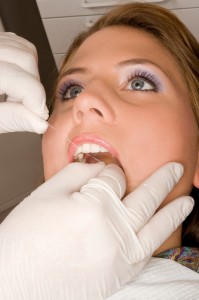Calendar
November 2024 M T W T F S S « Jun 1 2 3 4 5 6 7 8 9 10 11 12 13 14 15 16 17 18 19 20 21 22 23 24 25 26 27 28 29 30 -
Recent Posts
Recent Comments
Archives
Categories
Periodontal Disease
Periodontal Disease
Gum Disease can range from mild to severe. This is a picture of moderate to severe periodontal disease.
Advanced gum disease can affect any adult and even some children, what is most note worthy in this picture is the extra tooth. Look at the first picture and notice the extra incisor, there normally are 4 and 5 are clearly labeled!
Posted in Periodontal Disease
Leave a comment
Periodontal Disease
Advanced Gum Disease can affect people of all ages. This is a picture of the mouth of a young woman with advanced periodontal disease. Due to financial considerations, the treatment chosen was extraction of all but two lower teeth. This young woman ended up with a full upper denture, a lower partial denture, a much healthier mouth, a beautiful smile, greater self esteem all on a budget!
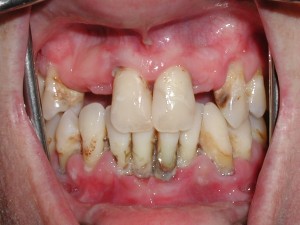
Posted in Periodontal Disease
Leave a comment
Periodontal Disease Treatments
America Dental Association has estimated that about 50% of adults over the age of 18 have early signs of periodontal disease.
Bad breath is a common sign of periodontal disease that happens when your gums become so infected that the gums begin to ooze and suffer consumes the infection.
Your gums are what hold your teeth in place and chronic periodontal disease is a major cause of tooth loss in adults. Your teeth can be free of decay but you can still suffer from periodontal disease and your teeth in result can be lost. There are some risk factors of developing periodontal disease smoking, oral hygiene, age, diabetes, bacteria and also your genetic disposition.
Periodontal disease is when the gums start to become inflamed and infected with mucus, food particles bacteria and accumulated plaque. Gums will start to swell at this point so much that more plaque and food gets trapped in the pocket. You will notice at this time your gums are no longer pink and taught they now begin to look puffy, swollen, red and frequently bleeding.
There are alternatives to treating periodontal disease by non surgical treatment such as a prescription mouth rinse in conjunction with brushing and flossing daily. For patients with more sever periodontal disease you may want to have a much deeper cleaning were the hygienist does one side of the mouth at a time. The hygienist then will get down to the base of the root and remove the calculus deposits that may be present. The hygienist will then flush out any bacteria or disease present in the gums. This is a pain free procedure that doesn’t always call for a needle. The hygienist also has a numbing gel called ORIKIS that numbs the gums long enough to clean the teeth. Also if you have deep pockets of more then 5mms deep the hygienist can also place a site specific antibiotic that is called ARESIN. The hygienist places the antibiotic in the deepest pockets that hardens over time with your blood and saliva. The ARESIN stays active for 21 days and helps clear up bacteria and infection caused by periodontal disease. Once the infection and bacteria is cleared up or under control the gums will start to adhere back to the roots of the teeth. After the periodontal disease is under control you must have more frequent cleaning recalls every 3 months to check the healing and monitor the periodontal disease to make sure the gums stay clean of debris that may get trapped in the gums. This insures the healing of periodontal disease. After the periodontal disease continues to heal you may eventually start having 4 month cleaning recalls. Again your mouth must be closely monitored to insure healing of periodontal disease. You will remain on 3 or 4 month recalls.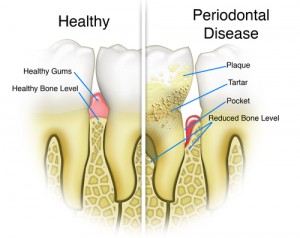
Posted in Gum Disease, Periodontal Disease
Leave a comment
Do You Have Periodontal Disease?
I came across this short little test that assesses your gum disease risk. Please click on the link below and see how you rate.
Posted in Gum Disease, Periodontal Disease
Leave a comment
Gum Disease and Pregnancy
For a long time we’ve known that risk factors such as smoking, alcohol use, and drug use contribute to mothers having babies that are born prematurely at a low birth weight.
Some studies have suggested the possibility of an additional risk factor – periodontal disease. Pregnant women who have periodontal disease may be more likely to have a baby that is born too early and too small. However, more research is needed to confirm how periodontal disease may affect pregnancy outcomes.
All infections are cause for concern among pregnant women because they pose a risk to the health of the baby. The Academy recommends that women considering pregnancy have a periodontal evaluation.
Posted in Gum Disease, Periodontal Disease
Leave a comment
Gum Disease
 Gum disease, also known as periodontal disease is a chronic intra-oral bacterial infection that does have systemic health implications.
Gum disease, also known as periodontal disease is a chronic intra-oral bacterial infection that does have systemic health implications.
We know that periodontal disease has significant infectious and inflammatory components and that it increases insulin resistance. Chronic inflammation and insulin resistance are both primary causes of athlerosclerosis, and athlerosclerosis is the primary driver of heart attacks and strokes.
Posted in Gum Disease, Periodontal Disease
Leave a comment
Fluoridated Water
What is fluoride, and why do we need it?
Fluoride is a naturally occurring mineral. Decades ago, health official’s realized that areas with high levels of fluoride in their water also had less tooth decay, spurring efforts to add fluoride in areas with lower levels. When you eat sugar or other refined carbohydrates, bacteria in the mouth produces acid that removes minerals from the surface of the tooth. Fluoride helps remineralize the tooth surface and prevent cavities,according to the federal Centers for Disease Control and Prevention.
Is the water supply the best way to deliver fluoride?
Health officials think so, because people take in water throughout the day, getting cavity protection. It also helps protect people who cannot afford regular dental care, a growing population in the current economic climate. “You don’t have to remember to do anything,” Bailey says. “It reaches people of all socioeconomic groups.”
What do I do if I don’t have fluoridated water?
Dr. Craig Oldham, president elect of the Hillsborough County Dental Association, recommends fluoride supplements for children 12 and under who live in areas without fluoridated water. “daily brushing is not enough,” he said, pointing out that ingesting fluoride not just placing it on the teeth is essential for tooth formation in children. Also, research has found that as people age and saliva production declines, fluoridated water also is protective.
Source: St. Petersburg Times, Thursday October 6,2011
By: RichardMartin
Posted in Periodontal Disease
Leave a comment
A healthy mouth can save your life!
Posted on June 26, 2011 by Dr. Paul Caputo DDS
Untreated Dental Disease Sooner or later, the vast majority of adults suffer from either tooth decay or gum disease. One of the bacterial types implicated in gum disease is “Porphyromonas gingivalis” which works its way below the gum line. If allowed to flourish these nasty microbes attack gum and bone tissue. Once this tissue erodes, teeth slowly loosen, become infected and ultimately may need to be extracted. These same bacteria are now known to be implicated in heart disease, diabetes, stroke and pregnancy complications.
Non-surgical treatment options for gum disease including prices and cost can be found here.
Posted in Gum Disease, Periodontal Disease
Leave a comment
Periodontal Disease Stages
It is estimated that more than half of all adults age 35 and older have early to advanced stages of periodontal disease. Periodontal disease (PD) is the primary cause of lost teeth after the age of 35 – not dental cavities!

What is periodontal disease ?
Periodontal disease is a chronic gum infection caused by plaque resulting in loss of bone support around the roots of teeth. Plaque is a thin film of bacteria that forms on teeth. Plaque converts to tartar if not cleared form teeth after 24hrs. Tartar irritates gums leaving them red, swollen and bleeding readily.
Eventually the gums peel away form teeth and create small pockets between the teeth and gums, slowly continuing to also destroy the supporting bone. Severe loss of the supporting bone is what loosens up teeth and make them incapable of functioning properly. Periodontal disease is often painless and will go undetected until bone loss is so severe that teeth are so loose they need to be extracted.
What are the signs ?
Early Stages:
• Bleeding gums when you brush or floss
• Red, swollen, tender gums
• Gums that have receded or shrunken away from teeth
Later Stages:
• Loose teeth, or teeth that have moved, or more spacing between teeth (especially front teeth) resulting in changes in bite or in the fit of dentures
• Foul smell or taste and/or pus that can be expelled when pressing on the gums
What can you do ?
The best way to treat periodontal disease is by early detection and prevention. A thorough examination can tell if you are at risk. Once diagnosed with periodontal disease, one must try to prevent further loss of supporting bone and/or other teeth.
Treatment usually involves a thorough scaling and root planing to remove plaque and built up tartar, thus allowing healthy gums tissues to reattach to root surfaces of teeth. Clean surfaces of teeth must be maintained by meticulous home oral hygiene and routine check-ups and cleaning.
Remember: There is really no cure for this “silent tooth killer”; cleanings can only dramatically slow down the disease process. Only early detection and prevention can make the difference between premature loss of teeth and a full compliment of healthy strong teeth.
Source: http://www.drchoo.com/images/preventive04.gif
Posted in Gum Disease, Periodontal Disease
Leave a comment
Waterpik vs Floss
Pros & Cons: Floss
Dental floss is an inexpensive way to help keep your teeth and gums healthy. MayoClinic.com indicates that floss is effective for cleaning tight spaces between teeth and will also scrape up and down the sides of each tooth. This is important because if plaque is not removed it can become tarter, a risk factor for the early stage of gum disease called gingivitis, according to the ADA.
On the other hand, the mechanical nature of floss can be abrasive. “Flossing can be irritating for people who have sensitive gums and may actually cause bleeding in some people,” Hayes notes. Also floss can’t be used by people who wear braces because it won’t penetrate the wires in order to reach the gums, Hayes adds.
Pros And Cons: Waterpik
One benefit of a Waterpik is that it’s gentle on the gums and is less likely to cause bleeding in people with sensitive gums, according to Hayes. A Waterpic is also ideal for people who wear braces — water will get behind the metal wires and flush out food particles. A Waterpik is sometimes recommended for people who have active gum disease because it flushes out bacteria from deep pockets that form when gums pull away from the teeth. “Floss can’t reach these pockets,” Hayes says. The downside: A Waterpik doesn’t remove plaque from teeth as well as floss. “Flossing scrapes off the sticky film of bacteria, while a Waterpic just rinses it,” Hayes explains. MayoClinic.com says using a Waterpik isn’t a substitute for flossing.
Source: http://www.livestrong.com/article/287399-waterpik-vs-floss/
Posted in Gum Disease, Periodontal Disease
Leave a comment















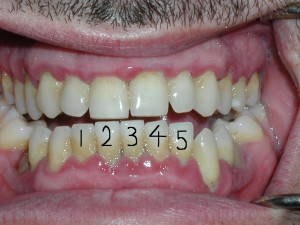
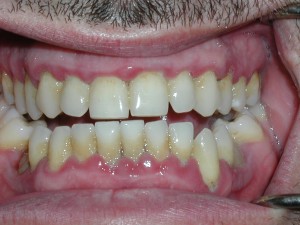
![images[5]](http://periodontaldisease.us/wp-content/uploads/2012/01/images5.jpg)
